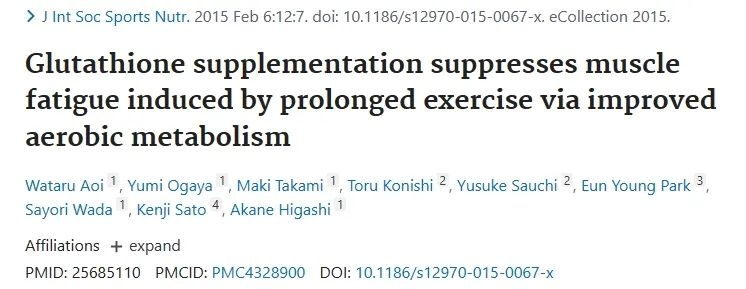Population aging has become a hot spot in modern society, and aging is also a life process that everyone needs to face. However, aging is often accompanied by the occurrence of many chronic diseases, and scientists are also trying to explore the aging process of humans, hoping to reduce the occurrence of diseases. We can also strengthen our body through healthy diet, regular work and rest, appropriate exercise and some food and drug assistance, so as to meet aging with a healthy and happy body and mind and reduce the occurrence of chronic diseases.
Writing here, Xiaobian can't help but think of glutathione. Glutathione can not only detoxify, antioxidant and increase the body's immunity, but also may improve the chronic diseases of aging and help people make exercise easier.
Glutathione and aging

In 2002, a foreign article published in the Journal of Laboratory and Clinical Medicine briefly described the possible effect of glutathione on anti-aging.
In a study of 176 healthy individuals, age was observed to be negatively associated with GSH, GSH/GSSG molar ratio, or GR activity. Age was positively correlated with glutathione-peroxidase and GSSG levels. Another study of 74 chronically ill patients reported that one-third of these patients had GSH levels below the lower limit of normal and GSSG levels similar to those in the control group. In another study, GSH levels were 17 percent lower in the 60-79 age group than in the reference group. In a representative study of a community-based group of older adults, higher glutathione levels were associated with less disease, better self-rated health, lower cholesterol, lower body mass index, and lower blood pressure.
The results showed that one-third of the elderly patients with chronic diseases had GSH levels below the lower limit of normal; Older adults with higher levels of glutathione have relatively fewer diseases, lower cholesterol levels, lower body mass index and lower blood pressure.
Glutathione and exercise
01. Glutathione reduces oxidative stress during exercise

In 2005, a foreign research team published an article in the Journal of the International Society of Sports Nutrition, explaining the effect of glutathione's antioxidant effect on exercise-induced oxidative stress.
A study by Clarkson et al. had subjects complete 50 maximum elbow flexor contractions before exercise, immediately after exercise, and 24, 48, 72, 96, and 120 hours post-exercise blood draws. They show that an increase in total glutathione in plasma was found in those individuals who already had higher circulating levels, which they believe is a greater adaptive response to disruptive exercise. Another study investigated changes in glutathione status after exercise, using 20-30 year old men who cycled for 40 minutes at 60% of their maximum oxygen consumption to try to determine the role of glutathione as a determinant of lipid peroxidation. After exercise, oxidized glutathione levels increased by about 50% as a result of exercise, indicating a large attack of oxidative stress. In addition, glutathione levels decreased by 13% after exercise, providing evidence that intracellular glutathione is utilized within the muscle or associated tissues, resulting in lower serum levels. The findings highlight the critical role of glutathione homeostasis in regulating exercise-induced oxidative stress. It also suggests that glutathione plays an important role in preventing oxidative stress-related lipid peroxidation.
The results show that glutathione can minimize the oxidative stress during exercise and protect the body to a greater extent.
02. Glutathione slows muscle fatigue during exercise

In 2015, a team Of foreign researchers published an article in The Journal Of The International Society Of Sports Nutrition that showed how glutathione supplementation improved muscle fatigue during exercise.
The researchers divided the ICR mice into four groups: a sedentary control group, a sedentary glutathione supplement group, an exercise control group, and a glutathione supplement exercise group. After 2 weeks, the exercise group ran on a treadmill at a speed of 25 m/min for 30 minutes. Intermuscular pH was measured immediately after exercise, and samples of hindlimb muscles and blood were collected to measure biochemical parameters. In a double-blind, cross-over study, eight healthy men (35.9 ± 2.0 years) were given glutathione or placebo for 2 weeks. Two weeks later, the subjects exercised at 40% of their maximum heart rate on a bicycle dynamometer for 60 minutes. The psychological state and blood biochemical parameters were examined after exercise. The results showed that in the mouse experiment, the glutathione supplementation group had significantly lower plasma non-esterified fatty acids after exercise compared to the exercise control group. Intermuscular pH value decreased with exercise. However, glutathione supplements prevented this reduction. Levels of peroxisome proliferator-activated receptor-γ, coactivator 1α protein, and mitochondrial DNA were significantly higher in the glutathione-supplemented sedentary group than in the sedentary control group (25% and 53% higher, respectively). In human studies, glutathione intake inhibited the rise of blood lactic acid. Psychological factors related to fatigue were significantly reduced in the glutathione trial compared to the placebo trial.
The findings suggest that glutathione supplementation can improve lipid metabolism and acidification of skeletal muscle during exercise, thereby reducing muscle fatigue.
Post time: Dec-19-2023


